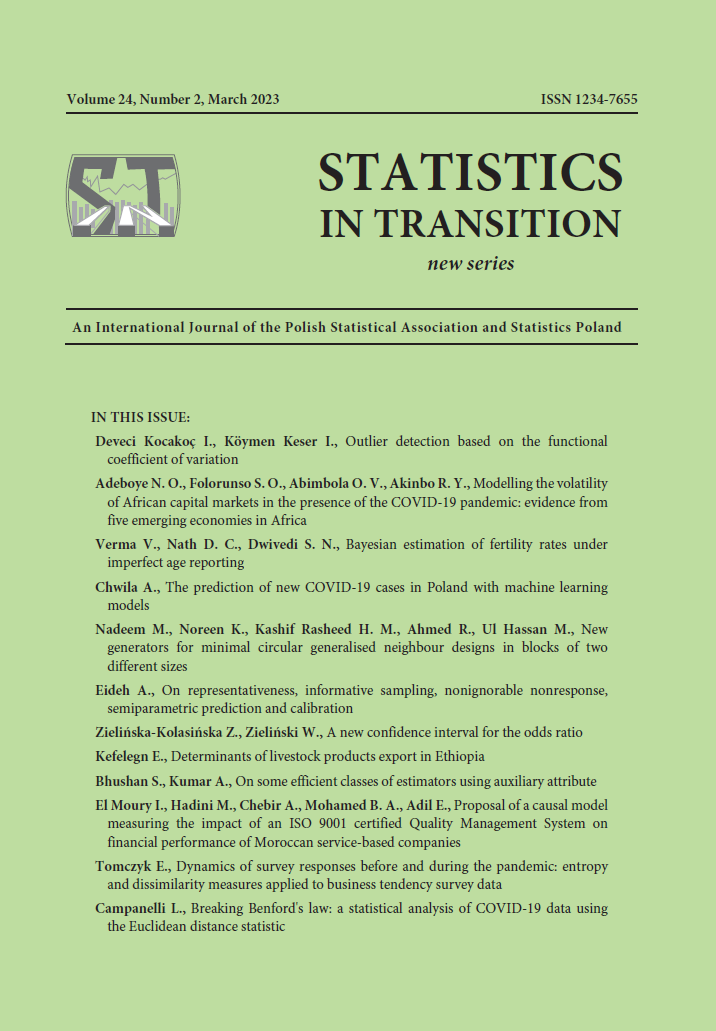ARTICLE
ABSTRACT
This article outlines the application of the Bayesian method of parameter estimation to situations where the probability of age misreporting is high, leading to transfers of an individual from one age group to another. An essential requirement for Bayesian estimation is prior distribution, derived for both perfect and imperfect age reporting. As an alternative to the Bayesian methodology, a classical estimator based on the maximum likelihood principle has also been discussed. Here, the age misreporting probability matrix has been constructed using a performance indicator, which incorporates the relative performance of estimators based on age when reported correctly instead of misreporting. The initial guess of performance indicators can either be empirically or theoretically derived. The method has been illustrated by using data on Empowered Action Group (EAG) states of India from National Family Health Survey-3 (2005–2006) to estimate the total marital fertility rates. The present study reveals through both a simulation and real-life set-up that the Bayesian estimation method has been more promising and reliable in estimating fertility rates, even in situations where age misreporting is higher than in case of classical maximum likelihood estimates.
KEYWORDS
Fisher information, square error loss function, age-specific marital fertility rate, Bayes estimator, maximum likelihood principle.
REFERENCES
Barakat, B. F., Dharamshi, A., Alkema, L. and Antoninis, M., (2021). Adjusted Bayesian Completion Rates (ABC) Estimation (No. at368). Center for Open Science.
Bhat, P. M., (1990). Estimating transition probabilities of age misstatement. Demography, 27(1), pp. 149–163.
Bhat, P. N., (1995). Age misreporting and its impact on adult mortality estimates in South Asia. Demography India, 24(1), pp. 59–80.
Bhatta, D., Nandram, B., (2013). A Bayesian adjustment of the HP law via a switching nonlinear regression model. Journal of Data Science, 11(1), pp. 85–108.
Borges, G. M., (2019). A Bayesian framework for estimating fertility from multiple data sources. Anais, pp. 1–8.
Coale, A. J., Li, S., (1991). The effect of age misreporting in China on the calculation of mortality rates at very high ages. Demography, 28(2), pp. 293–301.
Coal Ansley J., Trussell T. James, (1974). Model Fertility Schedules: Variation in the Age Structure of Childbearing in Human Populations. Population Index. 40(2), pp. 191– 228.
Daponte, B. O., Kadane, J. B. and Wolfson, L. J., (1997). Bayesian demography: projecting the Iraqi Kurdish population, 1977-1990. Journal of the American Statistical Association, 92(440), pp. 1256–1267.
Datta, G. S., Ghosh, J. K., (1995). On priors providing frequentist validity for Bayesian inference. Biometrika, 82(1), pp. 37–45.
Dechter, A. R., Preston, S. H., (1991). Age misreporting and its effects on adult mortality estimates in Latin America. Population Bulletin of the United Nations, (31-32), pp. 1–16.
Denic, S., Saadi, H. and Khatib, F., (2004). Quality of age data in patients from developing countries. Journal of Public Health, 26(2), 168–171.
Garenne, M., Tollman, S., Kahn, K., Collins, T. and Ngwenya, S., (2001). Understanding marital and premarital fertility in rural South Africa. Journal of Southern African Studies, 27(2), pp. 277–290.
Hussey, J. M., Elo, I. T., (1997). Cause specific mortality among older African Americans: Correlates and consequences of age misreporting. Social Biology, 44(3-4), pp. 227– 246.
Liu, P., Raftery, A. E., (2018). Accounting for Uncertainty About Past Values In Probabilistic Projections of the Total Fertility Rate for All Countries. arXiv preprint arXiv: 1806.01513.
Martin, J. A., Hamilton, B. E., Ventura, S. J., Osterman, M. J., Kirmeyer, S., Mathews, T. J. and Wilson, E. C., (2011). Births: final data for 2009. National vital statistics reports: from the Centers for Disease Control and Prevention, National Center for Health Statistics, National Vital Statistics System, 60(1), pp. 1–70.
Murray, C. J., Callender, C. S., Kulikoff, X. R., Srinivasan, V., Abate, D., Abate, K. H., ... and Bililign, N., (2018). Population and fertility by age and sex for 195 countries and territories, 1950?2017: a systematic analysis for the global burden of disease study 2017. The Lancet, 392(10159), pp. 1995–2051.
NFHS-III. (2005-2006). National Family Health Survey, International Institute for Population Sciences, Bombay.
Narasimhan, R. L., Retherford, R. D., Mishra, V. K., Arnold, F. and Roy, T. K., (1997). Comparison of Fertility Estimates from India’s Sample Registration System and National Family Health Survey.
Neal, S., Matthews, Z., Frost, M., Fogstad, H., Camacho, A. V. and Laski, L., (2012). Childbearing in adolescents aged 12–15 years in low resource countries: a neglected issue. New estimates from demographic and household surveys in 42 countries. Acta obstetricia et gynecologica Scandinavica, 91(9), pp. 1114–1118.
Nwogu, E. C., Okoro, C., (2017). Adjustment of Nigeria population censuses using mathematical methods. Canadian Studies in Population, 44(3-4), pp. 149–64.
Oh, J., (2018). A comparison and prediction of total fertility rate using parametric, nonparametric, and Bayesian model. The Korean Journal of Applied Statistics, 31(6), pp. 677–692.
Pullum, T. W., (2006). An assessment of age and date reporting in the DHS Surveys 1985- 2003.
Pathak, P., Verma, V., (2013). Projection of Indian Population by Using Leslie Matrix with Changing Age Specific Mortality Rate, Age Specific Fertility Rate and Age Specific Marital Fertility Rate. In Advances in Growth Curve Models. Springer, New York, NY, pp. 227–240.
Schoumaker, B., (2020). Fertility estimates from full birth histories and HDSS. In United Nations Expert Group Meeting on Methods for the World Population Prospects 2021 and Beyond.
Schmertmann, C. P., Hauer, M. E., (2019). Bayesian estimation of total fertility from a population’s age sex structure. Statistical Modelling, 19(3), pp. 225–247.
Singh, B. P., Singh, N. and Singh, S., (2020). Estimation of total fertility rate: an indirect approach using auxiliary information. Journal of the Social Sciences, 48(3), pp. 789– 798.
Szoitysek, M., Poniat, R. and Gruber, S., (2017). Age heaping patterns in Mosaic data. Historical Methods: A Journal of Quantitative and Interdisciplinary History, pp. 1– 26.
Yadava R. C., Kumar A., (2002). On an Indirect Estimation of Total Fertility Rate from Open Birth Interval Data, Demography India, 31(2), pp. 211–222.
Yi, Z., (2008). Reliability of age reporting among the Chinese oldest-old in the CLHLS datasets. In Healthy Longevity in China. Springer, Dordrecht, pp. 61–78.
